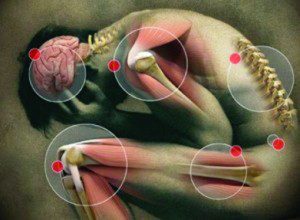By Jay Weitzner, MS, MATs, RTS


Now that you’ve picked a joint it’s time to investigate! Why might you be having this problem? Almost always, we hear lack motion being blamed on tightness. You hear how you can’t twist or bend or reach because something is too tight. You can’t pop up out of a chair because you’re too stiff and tight. We’re told you hunch forward because your chest and shoulders are too tight. It’s time for a paradigm shift in thinking. Because face it, many of you, and almost every one of my clients over the past 9 years, have tried countless ways to get that tight stuff to stop being tight so you can move better. Everyone continues to try to do things to relax the tight stuff. And it generally doesn’t work and if it does it never lasts. So if trying to get the tight stuff to stop being tight isn’t the answer, what is?
For the answer, let’s look at those joints. Crossing every joint are muscles. And those muscles are THE ONLY active tis-
sues in your body. By active I mean, the only thing you can control. Let’s test that right now… Try and move your skin. Try and move your hair. You can’t. Try and move a bone. While your bone might have moved through space, your muscle is what moved it. Try and move a tendon or a ligament. Can’t do it. Skeletal muscle is the only tissue you have any active control over. Everything else in your body is passive, meaning you can’t control it. Let’s put it right out there right now! With MAT, we are suggesting the lack of mobility people experience is the result of decreased muscle contraction ability instead of the usual notion of muscle being too tight. The tightness that is present is always the appropriate amount. If the muscles that move the joint can only contract (shorten) a little bit then the other muscles will get tighter sooner. If the muscles can fully contract they will cause a lot of motion and you won’t experience any inappropriate tightness. You see, the question is, “when should the joint stop moving?” Your body always knows and never gets it wrong. If the muscles causing the motion are functioning properly then you won’t have the sensation of tightness from other muscles. If muscles that create the motion are not functioning properly then other muscles will become tight sooner and you will experience the sensation of inappropriate tightness.
If you lose the ability to move a joint like you use to be able to we need to look at the only thing that has the ability to move that joint and see if it is functioning properly. That needs to be step one. With MAT, that is precisely what we do. We look to see if things are working. We look to see if the only thing that has the ability to move you is actually working.
Let’s get you working better.
Come in for a free evaluation.
To see MAT in the media: http://www.symmetryprecisionfitness.com/media-and-articles/
To see past MAT H&W articles:
http://www.symmetryprecisionfitness.com/category/health-wellness-magazine/
Muscle Activation Techniques
239.940.2121 | Jay@NoFadsAllFitness.com
NoFadsAllFitness.com
 Southwest Florida's Health and Wellness Magazine Health and Wellness Articles
Southwest Florida's Health and Wellness Magazine Health and Wellness Articles
